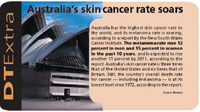- Case-Based Roundtable
- General Dermatology
- Eczema
- Chronic Hand Eczema
- Alopecia
- Aesthetics
- Vitiligo
- COVID-19
- Actinic Keratosis
- Precision Medicine and Biologics
- Rare Disease
- Wound Care
- Rosacea
- Psoriasis
- Psoriatic Arthritis
- Atopic Dermatitis
- Melasma
- NP and PA
- Skin Cancer
- Hidradenitis Suppurativa
- Drug Watch
- Pigmentary Disorders
- Acne
- Pediatric Dermatology
- Practice Management
- Prurigo Nodularis
- Buy-and-Bill
Article
Breakthrough may herald new age of cancer diagnosis
Leipzig, Germany — A new laser device measures cell elasticity to identify cancer cells with greater accuracy than traditional methods, according to Josef A. K?s, Ph.D., professor of physics and director of the Institute of Soft Matter Physics at the University of Leipzig, Leipzig, Germany. Applications include improved cancer diagnosis, identification of metastatic cells and improved harvesting of adult stem cells.

"Elasticity is an amazingly precise cell marker in terms of defining the degree of cell differentiation," Dr. Käs says. "This is well known. Biology books on oncology say cells have cytoskeletons. As normal cells develop, they become more differentiated with scaffolds, which are rigid."
Cancer cells, on the other hand, lose differentiation as they develop.

Biologists, on the whole, have considered elasticity too tiny a factor to measure. Those who have pursued the cause have deployed expensive, high-technology means, such as atomic force microscopes, achieving, at best, throughputs of 30 cells a day.
Dr. Käs' laptop device, which he describes as a "microfluidic optical stretcher," needs less than 50 tumor cells in a patient sample to diagnose cancer with 90 percent or better accuracy. This is a vast improvement over conventional methods that require up to 100,000 tumor cells to make a diagnosis that some report to be only 60 percent accurate. As a bonus, the stretcher can identify metastatic cells at locations distant to the original tumor site.
The device has a throughput of hundreds of cells per minute; it can be assembled with off-the-shelf technology at a cost of less than $30,000. Major components: two fiber lasers (readily available in the communications industry), a camera, a computer, a cell culture microscope and a microfluidic chip and pump.
"It's very easy to use," Dr. Käs tells Dermatology Times. "A technician takes cells by fine needle or Cytobrush, puts them in front of the machine, pushes start and two hours later has an answer."
Beginnings Dr. Käs became interested in cellular cytoskeletons early in his academic career and pursued the topic while doing postdoctoral work at Harvard Medical School from 1993 to 1996, theorizing that lasers could effectively stretch, rather than squeeze, cells. Proof of concept was achieved while working as an assistant professor of physics at the University of Texas in Austin. Now, his Leipzig team has produced five machines.
The clinical prototypes are on loan to hospitals in the Leipzig area. One physician has been using the stretcher to diagnose breast cancer and determine whether to perform a lumpectomy or mastectomy. Dentists are taking swabs to locate oral cancers, which are usually far progressed prior to detection. A cardiologist is harvesting stem cells to treat persistent bedsores. He hopes to someday have a machine capable of producing enough stem cells to also treat ailing hearts.
The stem cell connection Although the body has an abundance of adult stem cells, harvesting them is not easy. Currently, scientists use drugs to increase the number of white blood cells, 5 percent of which are stem cells. They next mark stem cells with fluorescent dyes or magnetic beads and separate them from the pack. The cost is high and viability poor.
"Stem cells are very similar to cancer cells," Dr. Käs says. "They can be isolated through microfluidic sorting, relying on inherent properties instead of dyes or beads."
The benefit is higher, more viable yields and lower costs.





